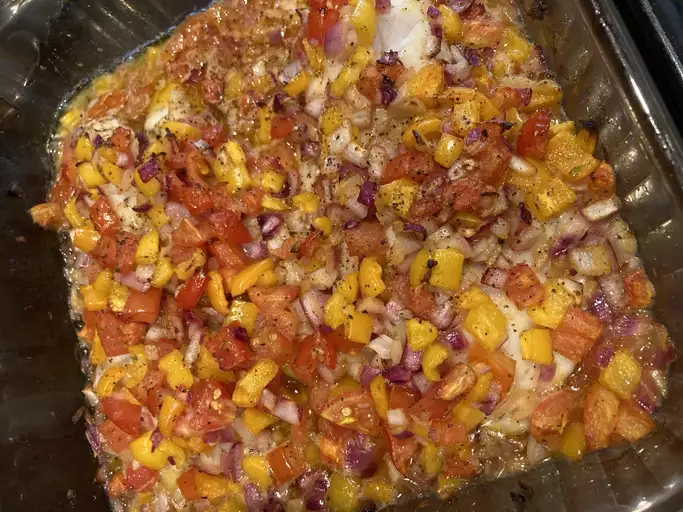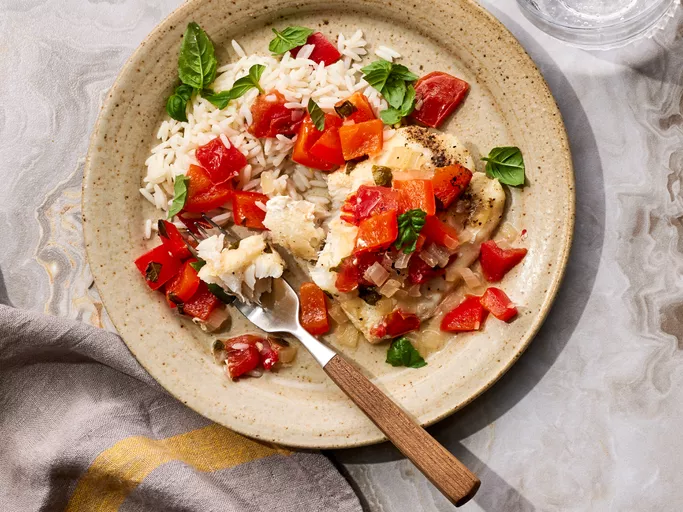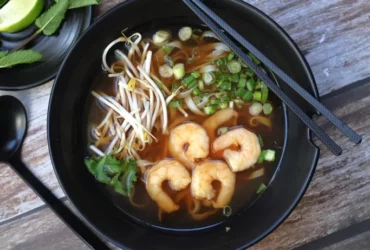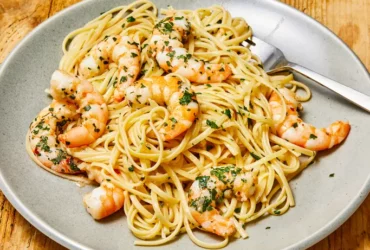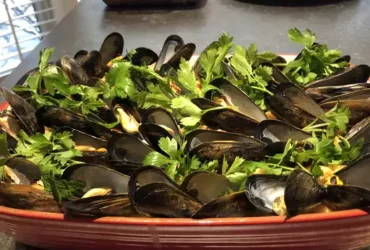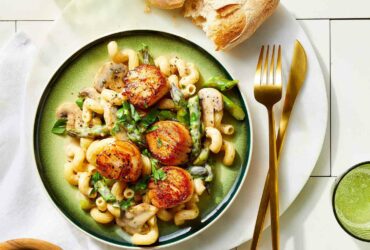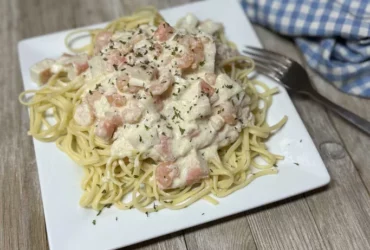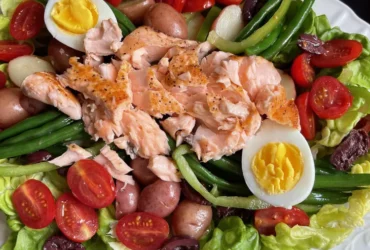Ingredients
Fish and Seasonings
The star ingredient in this recipe is cod fish, which is a mild-flavored white fish that pairs well with a variety of seasonings and flavors.
Cod fish is an excellent choice for baking in foil because it retains its moisture and flavor when cooked in a steamy environment, as the heat from the oven creates a steaming effect inside the foil packet.
When selecting cod fish for this recipe, look for fillets that are about 6 ounces each, which will ensure that they cook evenly and quickly.
For added flavor, you can sprinkle both sides of the cod with salt and pepper before placing it in the foil packet. This will help to bring out the natural flavors of the fish.
In addition to salt and pepper, some other seasonings you might consider using for this recipe include garlic powder, dried herbs like thyme or rosemary, or even a bit of paprika for a smoky flavor.
One important thing to keep in mind when cooking with cod is that it can be prone to drying out if overcooked. To avoid this, make sure to not overbake the fish, and aim for an internal temperature of 145°F (63°C) at most.
The seasonings you choose will ultimately depend on your personal taste preferences, but some popular options include:
- Italian seasoning: a blend of herbs that typically includes basil, oregano, thyme, and rosemary
- Lemon pepper: a combination of lemon zest and black pepper for a bright, citrusy flavor
- Cajun seasoning: a spicy blend of paprika, garlic powder, onion powder, and cayenne pepper
- Garlic butter: a mixture of softened butter, minced garlic, and chopped parsley or dill
- When cooking with cod in foil, it’s also worth considering the type of flavor you want to achieve. Do you want a light, delicate taste or something more robust and intense? The seasonings you choose will play a big role in determining the final flavor of your dish.
- In general, it’s better to err on the side of caution when seasoning fish, as you can always add more but it’s harder to remove excess seasoning. Start with a light hand and taste the fish as you go, adjusting the seasonings as needed.
Fresh cod fillets
Fresh cod fillets are a staple ingredient in many seafood dishes, including the popular baked cod in foil recipe. When selecting fresh cod fillets for this recipe, it’s essential to choose high-quality fish that is sustainable and fresh.
The ideal cod fillet should be firm to the touch, have a shiny appearance, and a mild smell. The flesh of the cod should be white or pale pink in color, with no visible signs of discoloration or bruising.
Cod is a cold-water fish that is rich in protein, omega-3 fatty acids, and low in saturated fats. It is an excellent source of various vitamins and minerals, including vitamin D, selenium, and phosphorus.
Fresh cod fillets can be found at most seafood markets or high-end supermarkets. If you’re having trouble finding fresh cod, consider purchasing frozen cod instead. Frozen cod that has been flash-frozen to prevent freezer burn can be just as good as fresh cod.
When storing fresh cod fillets in the refrigerator, it’s essential to keep them at a consistent refrigerated temperature below 40°F (4°C). Wrap the cod tightly in plastic wrap or aluminum foil to prevent moisture loss and contamination.
Before using cod fillets for baked cod in foil, make sure to pat them dry with paper towels to remove excess moisture. This helps create a crispy exterior when baking the fish in foil.
The size of the cod fillets can vary depending on your preference. For this recipe, you’ll want to choose cod fillets that are about 6 ounces each and approximately 1 inch thick. This will ensure that the fish cooks evenly and retains its moisture during the baking process.
Lemon juice
- When it comes to baking cod in foil, one essential ingredient stands out for its bright, citrusy flavor and numerous health benefits – lemon juice.
- Lemon juice is a concentrated liquid extracted from lemons, which are a type of citrus fruit rich in vitamin C and flavonoids.
- Its acidity helps to break down the proteins in fish, making it more tender and easier to digest. In addition, lemon juice complements the delicate flavor of cod perfectly, without overpowering it.
Here are some key characteristics of lemon juice that make it an excellent choice for baking cod:
- Pungency: Lemon juice has a sharp, citrusy flavor that adds depth and brightness to the dish.
- Acidity: The acidity in lemon juice helps to break down the proteins in fish, making it more tender and easier to digest.
- Antioxidant properties: Lemon juice is rich in vitamin C and flavonoids, which have antioxidant properties that can help protect against cell damage and promote overall health.
To use lemon juice in your baked cod recipe, you can add it directly to the foil or mix it with olive oil, herbs, and spices for a marinade.
Here’s a basic guideline for using lemon juice when baking cod:
- Amount: Use 2-3 tablespoons of lemon juice per pound of cod.
- Ratio: Mix the lemon juice with olive oil, herbs, and spices in a ratio of 1:2 or 1:3 (lemon juice to oil).
- Temperature: Bake at 400°F (200°C) for 8-12 minutes or until the fish is cooked through.
Remember to adjust the amount of lemon juice according to your personal taste preferences and the specific recipe you’re using.
Garlic powder
Garlic powder is a popular spice commonly used to add flavor to various dishes, including baked cod recipes.
As one of the key ingredients in many baked fish recipes, garlic powder serves as a convenient alternative to fresh or roasted garlic, offering an easy and consistent way to infuse food with its characteristic pungency and aroma.
The primary function of garlic powder is to enhance flavor by introducing a subtle yet distinct savory taste that complements the natural flavors of ingredients such as cod, herbs, lemon juice, and other spices commonly used in baked fish recipes.
Garlic powder’s role in baking is versatile and can be applied in various ways depending on personal preference and specific recipe requirements.
Some common applications for garlic powder include mixing it with olive oil to create a marinade or rub for the cod before baking, sprinkling it over the fish as part of a seasoning blend, or incorporating it into sauce or dressing used as a topping for baked cod.
The intensity of garlic flavor can be adjusted by using more or less of the powder according to taste preferences.
In the context of the Baked Cod in Foil Recipe, garlic powder serves not only to season the cod but also to complement the other ingredients such as lemon, herbs, and spices used within the foil packet.
Paprika
Paprika is a popular spice made from ground bell peppers or sweet peppers and is often used to add flavor and color to various dishes, including the Baked Cod in Foil recipe.
The most common type of paprika is sweet paprika, which has a mild, slightly sweet flavor and a bright red color. Sweet paprika is derived from bell peppers that have been dried and ground, resulting in a smooth, fine powder.
Another type of paprika is smoked paprika, also known as smoked sweet paprika or Spanish paprika. Smoked paprika has a distinct smoky flavor due to the fact that it’s made from peppers that have been smoked over oak wood fires during drying.
Paprika can add depth and warmth to various dishes, making it an excellent addition to the Baked Cod in Foil recipe. The sweet, slightly smoky flavor of paprika complements the delicate taste of cod perfectly.
When selecting a paprika for use in this recipe, look for a high-quality, pure sweet or smoked paprika that’s free of additives and artificial ingredients. This will ensure that your dish tastes its best.
To prepare the paprika for use, simply sprinkle it over the cod fillets before wrapping them in foil. You can also mix the paprika with other spices, such as garlic powder and salt, to create a flavorful blend.
The amount of paprika used will depend on your personal preference, so feel free to experiment and adjust the seasoning to taste.
In addition to adding flavor to the cod, paprika can also help to enhance its color. The bright red hue of sweet paprika or the rich brown color of smoked paprika can add a pop of color to the finished dish, making it visually appealing as well as delicious.
Salt and pepper
The key to preparing a delicious Baked Cod in Foil dish lies in selecting the right ingredients, with salt and pepper being among the most fundamental components.
Salt, as one of the essential seasonings in cooking, plays a crucial role in enhancing flavor and texture. It helps bring out the natural taste of fish like cod by balancing its fatty acids and moisture content.
There are several types of salt available for use in cooking, each with its unique properties and characteristics. Some common types include table salt, kosher salt, Himalayan pink salt, sea salt, and smoked salt, among others. The choice between these varieties often depends on personal taste preferences as well as the specific recipe being used.
Pepper is another fundamental seasoning that complements the flavor of cod well, particularly when combined with other ingredients like lemon juice, garlic, or herbs. Like salt, there are various types of pepper available for different applications in cooking.
The most common type of pepper used in cooking is black peppercorn, which contains a compound called piperine that provides its characteristic flavor and aroma. White pepper, on the other hand, is derived from the inner seed of the peppercorn fruit after it has been removed from its outer shell, giving it a milder taste compared to black pepper.
In the context of baking cod in foil, both salt and pepper are typically used as part of a marinade or seasoning mixture. This ensures that they penetrate evenly throughout the fish, enhancing its flavor and texture without overpowering it. When preparing the dish, it’s essential to use the right amount of salt and pepper to avoid over-seasoning or under-seasoning the cod.
A general guideline for seasoning with salt is to use about 1/4 teaspoon per pound of fish. For pepper, a lighter hand is usually recommended, as too much can overpower the delicate flavor of the cod. It’s also worth noting that some recipes may call for additional seasonings or spices beyond just salt and pepper, so it’s essential to follow the specific instructions provided.
Cooking Liquid
The key to preparing a delicious Baked Cod in Foil Recipe lies in selecting high-quality ingredients and understanding the role of the cooking liquid in enhancing flavors.
A typical Baked Cod in Foil Recipe calls for fresh cod fillets, preferably with skin removed, as it can create an unpleasant texture during cooking. Freshness is crucial when handling fish, so choose cod that smells slightly sweet and has firm flesh.
When it comes to the Cooking Liquid, several ingredients play a significant role in elevating the dish’s flavors:
The primary component of the Cooking Liquid is water. Water acts as a medium for transferring flavors from aromatics and seasonings into the fish, creating a harmonious balance of taste.
For added depth, consider incorporating citrus juice, such as lemon or lime, which helps break down proteins in the fish while contributing its zesty flavor profile.
Aromatic vegetables like onion, garlic, and herbs (such as parsley, thyme, or rosemary) can be added to create a flavorful base for the Cooking Liquid. Simply chop these ingredients finely, allowing them to infuse their essence into the water.
Sometimes, you may choose to add a small amount of acidic ingredient like white wine or stock (chicken or fish) to create a more complex flavor profile, which can enhance the overall taste experience of the baked cod.
Finally, it is essential to note that the Cooking Liquid should not overpower the delicate taste of the cod; its primary role is to complement and enhance the flavors already present in the dish.
Water
The key to achieving perfectly cooked cod in foil is to select fresh and high-quality ingredients, including the fish itself.
In this recipe, we will be using cod as our primary protein source. It’s essential to choose cod that is firm, flaky, and has a mild flavor profile.
Other necessary ingredients include:
- Lemon juice or slices – This adds a burst of citrus flavor to the dish and helps to balance out the richness of the fish.
- Garlic cloves, minced – This is used to add depth and aroma to the recipe.
- Herbs such as parsley, dill, or thyme – Fresh herbs can enhance the flavor profile of the dish and provide a pop of color on the plate.
- Salt and pepper – These are used to season the fish to taste.
- Butter or oil – This is used to add moisture and flavor to the dish. You can choose between unsalted butter, salted butter, or a neutral-tasting oil like olive or avocado oil.
When it comes to water, it’s essential to use cold, fresh water in the recipe. You can either use tap water or bottled water, depending on your preference and what is available in your area.
The amount of water needed will depend on the size of your fish and how much liquid you prefer in the foil packet. A good rule of thumb is to use about 1/4 cup of water for every 12 oz (340g) of cod.
You can also add a few slices of lemon or some chopped herbs to the water if you want to infuse it with extra flavor and aroma before placing the fish in the foil packet.
White wine (optional)
Cooking with white wine can elevate the flavor and aroma of baked cod, adding a richness to the dish. However, it’s worth noting that using white wine is optional.
When choosing a white wine for cooking, a dry variety such as Sauvignon Blanc or Pinot Grigio works well. These wines have crisp acidity and flavors that will complement the delicate taste of cod without overpowering it.
- Sauvignon Blanc: Known for its citrus and grassy notes, this wine pairs particularly well with fish.
- Pinot Grigio: Offers a crisp flavor profile with hints of green apple and pear, making it an excellent choice for baked cod.
The key is to use a small amount of white wine in the recipe. A good rule of thumb is to use about 1/4 cup of wine per pound of fish. This will allow the flavors to meld together without overpowering the cod.
When using white wine, be sure to deglaze the pan before adding it to the recipe. This means cooking the liquid until it’s almost completely reduced, scraping up any browned bits from the bottom of the pan.
This step is essential in extracting the maximum flavor from the wine and incorporating it into the dish. After deglazing the pan, you can then add the white wine to the recipe as instructed.
Additional Flavorings
To enhance the flavor of the baked cod in foil recipe, there are several ingredients and additional flavorings that can be used.
Ingredients
- Fresh herbs: Chopped parsley, dill, or thyme add a bright and fresh flavor to the dish. You can use one herb or combine different ones for a unique taste.
- Lemon juice: A squeeze of fresh lemon juice adds acidity and helps bring out the flavors of the cod. You can also use lemon zest for added citrus flavor.
- Garlic: Mince garlic and mix it with butter or olive oil to create a flavorful sauce that complements the fish.
- Soy sauce: Use soy sauce to add a salty, umami flavor to the dish. Mix it with lemon juice and herbs for a balanced taste.
- Honey: A drizzle of honey adds sweetness to the dish, balancing out the savory flavors.
Additional Flavorings
Spices
- Cumin: Ground cumin adds a warm and earthy flavor that pairs well with fish.
- Paprika: Smoked paprika gives the dish a smoky, savory flavor.
Seafood seasonings
- Dried dill weed: Add dried dill weed to the fish for an intense and fresh flavor.
- Old Bay seasoning: This spice blend adds a unique taste that’s often associated with seafood dishes.
Remember, the key is to balance your flavors so each ingredient complements the others. Don’t be afraid to experiment and adjust the amounts of each ingredient to suit your personal taste.
Chopped fresh parsley
The chopped fresh parsley used in this Baked Cod in Foil recipe is a crucial ingredient that adds not only flavor but also visual appeal to the dish.
Parsley, with its bright green color and delicate leaves, is one of the most widely used herbs in cooking and garnishing. It has a mild, fresh taste that complements a variety of flavors, from fish to salads and soups.
There are two main types of parsley: curly-leafed and flat-leafed. Both have their own unique appearance and slightly different flavor profiles.
In the Baked Cod in Foil recipe, it’s essential to use fresh parsley for optimal flavor and aroma. Freshness can be determined by checking the leaves’ texture and color – they should be crisp, green, and free of any signs of wilting or yellowing.
Parsley pairs particularly well with fish like cod due to its delicate taste, which doesn’t overpower the natural flavors of the seafood. When used as a garnish, parsley adds a pop of color and freshness to the dish.
In the Baked Cod in Foil recipe, the chopped fresh parsley is likely used towards the end of the cooking process to preserve its vibrant color and flavor.
Diced onions
Diced onions are a fundamental ingredient in many recipes, including the popular Baked Cod in Foil dish. They add a depth of flavor and texture that complements the delicate taste of cod.
The type of onion used for dicing is typically a mild or sweet onion, such as a Vidalia or yellow onion. These varieties have a lower sulfur content compared to strong onions like red or white onions, which makes them sweeter and less pungent.
To dice an onion, you’ll need to peel it first by removing the outer layer of skin. Then, place the onion on its side and cut off both ends to create a stable base. Next, make parallel cuts from top to bottom without cutting through the root end.
After that, perpendicular cuts are made to create small, uniform pieces of about 1/4 inch in size. Be careful not to apply too much pressure while cutting, as this can cause the onion to become mushy or develop an unpleasant texture.
In the case of Baked Cod in Foil, diced onions are usually added along with other aromatics like lemon juice and herbs to create a flavorful packet around the cod fillet. The onions will caramelize during baking, which enhances their sweetness and pairs perfectly with the fish.
One thing to note when working with diced onions is that they can release sulfur compounds when cut or cooked, which may cause some people to experience irritation or tearing while chopping. This reaction can be minimized by using a very sharp knife, cutting under cold running water, or keeping the area well-ventilated.
Ultimately, choosing the right type of onion and handling it correctly will result in perfectly diced onions that add richness and depth to your Baked Cod in Foil dish without overpowering the delicate flavor of the fish.
Instructions
Preparation
- The first step in preparing the Baked Cod in Foil recipe is to gather all the necessary ingredients and equipment.
- Gather a few pieces of fresh cod, weighing approximately 6 ounces (170g) each.
- Select some high-quality olive oil, preferably extra-virgin for its distinct flavor and nutritional benefits.
- In addition to olive oil, prepare the following aromatics: lemon slices, garlic cloves, thyme sprigs, and rosemary sprigs.
- Fresh herbs like thyme and rosemary add an aromatic depth to the dish, so it’s essential to use high-quality sprigs.
- Next, prepare the lemon slices by cutting them into thin wedges. The acidity of the lemons will help to balance the richness of the cod.
- Cut the garlic cloves in half and mince them finely to release their flavors and aroma.
- Take the aluminum foil, which is perfect for cooking fish at home due to its non-stick properties and ease of cleanup.
- Cut a few large pieces of aluminum foil, approximately 18 inches (45cm) square each, to create individual packets for each cod fillet.
- Have the following equipment ready: baking sheet, tongs or spatulas, and a measuring spoon.
- Making sure you have all these ingredients and equipment will make the cooking process smoother and more enjoyable.
- This detailed preparation will ensure that your Baked Cod in Foil turns out perfectly cooked, flavorful, and moist.
Rinse the cod fillets under cold water, pat them dry with a paper towel.
To ensure the cod fillets are perfectly seasoned and cooked to perfection, it’s essential to start by preparing them properly.
The first step in this process is to rinse the cod fillets under cold water, which serves two primary purposes. Firstly, rinsing the fish removes any loose scales or debris that may be present on its surface, giving you a cleaner and more even cooking result.
Secondly, rinsing the cod fillets under cold water helps to remove any impurities or contaminants that might have accumulated during transportation or storage. This not only improves the overall flavor and texture of the fish but also reduces the risk of foodborne illnesses.
Once you’ve rinsed the cod fillets thoroughly, it’s time to pat them dry with a paper towel. Patting the fish dry is crucial as it helps to prevent excess moisture from interfering with the cooking process.
Excess moisture can cause the fish to steam instead of sear when placed in the oven, leading to a less flavorful and texture-rich final product. By gently patting the cod fillets dry with a paper towel, you’re allowing them to develop a nice crust on the outside while remaining juicy and tender on the inside.
In the context of this Baked Cod in Foil Recipe, rinsing and drying the cod fillets properly sets the stage for even cooking, enhances flavor, and ensures the fish is cooked to perfection when baked in foil with your choice of aromatics and seasonings.
In a small bowl, mix together lemon juice, garlic powder, paprika, salt, and pepper.
Instructions for preparing delicious baked cod in foil involve several key steps that require attention to detail. To start, it’s essential to gather all the necessary ingredients and tools before commencing the cooking process.
The first step involves preheating the oven to 400 degrees Fahrenheit (200 degrees Celsius). This ensures that the oven reaches a consistent temperature, which is crucial for even cooking of the cod fillets. While waiting for the oven to heat up, it’s an ideal time to prepare the seasoning mixture.
Within a small bowl, combine lemon juice, garlic powder, paprika, salt, and pepper. This blend provides an excellent balance of flavors, which complements the mild taste of cod. Make sure to mix the ingredients well until they are evenly distributed throughout the bowl.
Once the seasoning mixture is prepared, take a large sheet of aluminum foil and lay it flat on a clean surface. Place two cod fillets in the center of the foil, leaving enough space between them for even cooking. Sprinkle a generous amount of the prepared seasoning mixture over each cod fillet, ensuring that they are well-coated with the flavors.
Next, place a few slices of lemon on top of each cod fillet, followed by some chopped fresh herbs such as parsley or dill. This adds an extra layer of flavor and aroma to the dish. Drizzle a small amount of olive oil over the cod, which helps retain moisture during cooking.
Now it’s time to fold the foil into packets around each cod fillet. Make sure to seal the edges tightly by folding them twice and pressing firmly. This will help maintain the flavors inside while allowing for even heat distribution. Repeat this process for the remaining cod fillets, if using multiple.
Place the foil packets in a baking dish or on a sheet pan, leaving about 1 inch (2.5 cm) of space between each packet. Bake in the preheated oven for 12-15 minutes or until the cod is cooked through and flakes easily with a fork. Remove from the oven and let rest for a few minutes before serving.
When ready to serve, carefully open the foil packets by cutting along the edges with a sharp knife or kitchen shears. Be careful not to spill any of the juices or flavors that have accumulated inside during cooking. Serve immediately while hot, garnished with additional fresh herbs if desired. This baked cod in foil recipe is perfect for a quick and easy dinner option, packed with flavor and nutrients from the sea.
Brush the mixture evenly onto both sides of the cod fillets.
To brush the mixture evenly onto both sides of the cod fillets, you will need to carefully apply a uniform layer of the mixture to each side of the fish.
Begin by holding one of the cod fillets firmly on a flat surface, such as a plate or cutting board. Make sure the fillet is secure and won’t move around while you’re applying the mixture.
Next, take your brush (preferably a pastry brush or a silicone brush) and dip it into the mixture. Wipe off any excess mixture from the brush by gently tapping it against the side of the bowl or container holding the mixture.
Now, hold the brush at a 90-degree angle to the surface of the cod fillet, with the bristles almost touching the fish. Gently sweep the brush across the surface of the fish in long, smooth strokes, making sure to cover the entire area evenly.
You may need to use a bit of pressure to get the mixture to stick to the fish, but be careful not to press too hard and create uneven patches or bruise the fish. It’s better to err on the side of caution and apply the mixture in thin layers, allowing each layer to dry slightly before adding more.
Once you’ve applied a uniform layer of mixture to one side of the cod fillet, flip it over and repeat the process for the other side. Make sure to get into all the crevices and corners where the mixture might tend to pool or accumulate.
By following these steps, you should be able to achieve an even, uniform coating of the mixture on both sides of the cod fillets, which will help them cook evenly in the oven and result in a delicious, flaky finish.
Cooking in Foil
Assembling the Foil Packet
The technique of cooking in foil, also known as “foil packet” or “aluminum foil baking,” allows for easy preparation and cleanup while maintaining a delicate flavor. This method can be applied to various dishes, such as baked cod.
Here’s how to prepare the foil packets for baked cod:
Step 1: Choose Fresh Ingredients
Select a fresh cod fillet, weighing around 6 ounces. Make sure it is free from any bones or scales. Additionally, pick some sliced lemons and onions.
Step 2: Prepare the Flavorings
Cut two cloves of garlic into thin slices and chop a small sprig of fresh parsley. These will be used to infuse flavor within the foil packet.
Step 3: Assemble the Foil Packet:
- Preheat your oven to 400°F (200°C). This high temperature is ideal for cooking delicate fish like cod in a short period.
- Take an 18-inch piece of aluminum foil and lay it flat on the counter. Make sure the shiny side faces down, as this will prevent food from sticking.
- Place a cod fillet in the center of the foil sheet, leaving some space around it for the other ingredients.
- Add a few slices of lemon to one side of the fish, followed by some onion slices and a sprinkle of chopped parsley. Make sure not to overfill the packet with vegetables, as this may cause them to steam instead of roast during cooking.
- Sprinkle both sides of the cod fillet with minced garlic for added flavor. You can use about 1/4 teaspoon per side.
- Drizzle a tablespoon or two of olive oil over the fish and vegetables. This will help keep everything moist and flavorful during cooking.
- Fold the foil packet in half to seal it, making sure to press out any air pockets inside. This helps ensure even cooking and prevents steam from accumulating within the packet.
- Place the sealed foil packet on a baking sheet lined with parchment paper or aluminum foil. This makes cleanup easier after cooking.
Step 4: Cook the Foil Packet
Bake the cod in the preheated oven for about 8-12 minutes, depending on your desired level of doneness. The internal temperature should reach at least 145°F (63°C) to ensure food safety.
Step 5: Serve and Enjoy
Once cooked, carefully remove the foil packet from the oven using oven mitts or tongs. Open the packet by cutting along the folded seam with a sharp knife or kitchen shears. Be careful not to burn yourself on steam escaping from the packet.
Your baked cod in foil is now ready to be served! It’s an impressive dish that combines delicate flavors and tender textures. Serve it with your choice of side dishes, such as steamed vegetables or mashed potatoes, for a complete meal.
Cut a large piece of aluminum foil, big enough to wrap around the cod fillet with some extra room on each side.
To get started, you’ll need a large piece of aluminum foil that’s big enough to wrap around the cod fillet with some extra room on each side. This will allow for even cooking and prevent the fish from drying out.
The size of the foil will depend on the size of your cod fillet, but as a general rule, you’ll want to use at least 12-18 inches of foil per pound of fish. So if you’re working with a large fillet, you may need multiple pieces of foil or a larger sheet.
Once you have your foil ready, it’s time to prepare the cod. Rinse the fillet under cold water and pat it dry with paper towels to remove any excess moisture. This will help the fish cook evenly and prevent steam from building up inside the foil packet.
Next, season the cod with your desired herbs and spices. You can use a simple seasoning blend or get creative with some more complex flavors like lemon, garlic, and dill. Just be sure to taste as you go and adjust the seasoning accordingly.
Now it’s time to assemble the foil packet. Place the cod fillet in the center of the aluminum sheet, leaving a 2-3 inch border around each side. You can fold the excess foil over the fish to create a seal, but be sure not to overlap the edges too much or you’ll risk steaming the fish instead of baking it.
Place any additional ingredients like vegetables, herbs, or aromatics on top of the cod. This could include sliced lemons, minced garlic, chopped fresh parsley, or even some diced potatoes. Just be sure not to overload the foil packet – you want to allow for good airflow and even cooking.
Finally, fold the excess foil over the fish to create a tight seal. Make sure the edges are secure and there are no gaps where steam can escape. This will help the cod cook evenly and prevent it from drying out.
Place the foil packet in the oven at 400°F (200°C) for 12-15 minutes, or until the fish is cooked through and flakes easily with a fork. You may need to adjust the cooking time based on the size of your fillet and the thickness of the aluminum foil.
Once the cod is cooked, remove it from the oven and carefully open the foil packet to reveal the deliciously baked fish inside. Serve immediately, garnished with fresh herbs or lemon wedges if desired.
Place one cod fillet in the center of the foil.
Cooking in foil, also known as baking in foil or steam cooking in foil, is a popular method for preparing a variety of foods, including fish, vegetables, and even meats. This technique involves wrapping food in aluminum foil to create an impervious environment that helps to retain moisture and flavors, resulting in tender and juicy cooked dishes.
One of the most delicious ways to cook fish using this method is with the Baked Cod in Foil Recipe, which requires only a few simple ingredients. To start, you will need a cod fillet as the main ingredient. Fresh or frozen cod fillets work equally well for this recipe, so use whichever is available.
Place one cod fillet in the center of the foil, making sure it’s not overlapping with any edges. This allows even cooking and prevents the fish from getting steamed to death instead of baked. You can add a few slices of lemon on top of the fish for extra flavor, as well as some chopped fresh herbs like parsley or dill.
Next, sprinkle some salt and pepper over the cod fillet, but be careful not to overdo it – you want to season the fish without overpowering its delicate taste. You can also add a pinch of paprika or garlic powder for extra flavor, if desired.
Now that your cod is prepared, it’s time to wrap it in foil. Fold one edge of the foil over the cod and then fold the other edges over as well, creating an enclosed package. Make sure the seams are sealed tightly so that steam can build up inside the pouch and cook the fish evenly.
Place the wrapped cod on a baking sheet lined with parchment paper and bake in a preheated oven at 400°F (200°C) for about 10-12 minutes per pound of fish. For example, if you have a one-pound cod fillet, it should take around 10-12 minutes to cook through.
When the cooking time is up, carefully remove the foil from the baking sheet and check the internal temperature of the fish with a meat thermometer. The cod should register at least 145°F (63°C) internally for medium-rare, while well-done cod will be cooked to an internal temperature of 165°F (74°C).
Once your Baked Cod in Foil Recipe is cooked to perfection, carefully remove the fish from the foil and serve immediately. You can garnish with some chopped parsley or lemon wedges on top for a pop of color and extra flavor.
Drizzle water and white wine (if using) over the fish, making sure not to spill any onto the foil.
Cooking in foil is a great way to prepare delicate fish like cod without it falling apart or overcooking. In this method, you’ll create a flavorful and moist environment that helps the fish cook evenly. To start, preheat your oven to 400°F (200°C). While the oven is heating up, let’s focus on preparing our ingredients for the dish.
First, choose some fresh cod fillets. You can use either frozen or fresh cod, but make sure to thaw it if using frozen. Cut the fillets into a manageable size and shape them into even portions, about 6 ounces each. Remove any bloodlines or dark meat, as they can be tough.
Next, prepare your seasonings. You’ll need some salt, pepper, lemon juice, garlic powder, and dried herbs like thyme and parsley. Mix these ingredients together in a small bowl to create your seasoning blend. Be sure to use the freshest and highest-quality seasonings you can find to get the best flavor.
Now it’s time to assemble our foil packets. You’ll need 4-6 pieces of aluminum foil, depending on how many servings you’re making. Cut a piece of foil large enough to wrap around the fish fillet with some extra room for folding. Place a fish fillet in the center of each foil square.
Drizzle water and white wine (if using) over the fish, making sure not to spill any onto the foil. This will help create moisture and add flavor to our dish. Sprinkle your seasoning blend evenly over the top of the fish, making sure to get some on both sides. You can also add some sliced lemon or chopped herbs for extra flavor.
Now fold the edges of the foil up over the fish, creating a tight seal to prevent steam from escaping. Make sure to press the foil firmly onto the fish to create a secure packet. Repeat this process with the remaining ingredients and serve immediately after baking.
Bake the packets for 8-12 minutes, or until the fish is cooked through and flakes easily with a fork. You can also check the internal temperature of the fish by inserting an instant-read thermometer into the thickest part of the fillet. The recommended internal temperature for cod is between 145°F (63°C) and 150°F (65°C).
Once the fish is cooked, carefully remove it from the oven and let it rest in the foil packets for a few minutes before serving. This will help the juices redistribute and the fish to stay moist. Serve hot with your choice of sides, such as rice pilaf, roasted vegetables, or a simple green salad.
Sprinkle chopped parsley and diced onions on top of the fish.
Cooking in foil, also known as steaming in foil, is a popular method for preparing delicate fish like cod. This technique helps retain moisture and flavor, while minimizing the risk of overcooking.
In this recipe, we will be cooking baked cod in foil, which is an adaptation of the traditional method that incorporates baking to enhance the flavors. To start, you’ll need a few ingredients:
- 1-2 cod fillets (depending on serving size)
- 1/4 cup lemon juice
- 2 cloves garlic, minced
- 1 tablespoon olive oil
- Salt and pepper to taste
- Cooking foil (heavy-duty aluminum or parchment paper)
To prepare the cod for baking in foil, follow these steps:
- Preheat your oven to 400°F (200°C).
- Cut a large piece of heavy-duty aluminum foil or parchment paper and place it on a flat surface.
- Lay the cod fillet(s) in the center of the foil, leaving some space between them if using multiple fillets.
- In a small bowl, mix together the lemon juice, garlic, olive oil, salt, and pepper. Pour this mixture over the cod, making sure each fillet is coated evenly.
- Bring up the sides of the foil to create a packet around the cod, then fold the top edge of the foil over to seal the packet.
- Place the packets on a baking sheet lined with parchment paper and bake in the preheated oven for 8-12 minutes per pound of cod, or until it’s cooked through and flakes easily with a fork.
During the last few minutes of cooking, sprinkle chopped parsley and diced onions on top of the fish. This adds an extra burst of flavor and aroma to the dish. Remove the packets from the oven, carefully open one of them (be careful as steam will escape), and serve immediately. Serve the cod in the foil packet, garnished with additional parsley and lemon wedges if desired.
Fold the foil over the fish to seal it completely.
This step is crucial to ensuring that the fish cooks evenly and retains its moisture. To fold the foil over the fish, start by bringing the two long edges together and then folding them over towards you.
Press the foil down gently to ensure it is secure and there are no air pockets. You should see the fish surrounded by a compact layer of foil.
Making sure the edges are sealed will prevent steam from escaping during cooking, which is essential for keeping the fish juicy and tender.
It’s also important to make sure that the edges are tightly folded to prevent any leaks or gaps in the seal. You can test this by gently tugging on the foil – if it doesn’t move, you know the edges are securely sealed.
Once the foil is sealed over the fish, you can place it in the oven and start cooking according to your desired method, whether that’s baking or grilling.
The folded foil acts as a steam chamber, where moisture from the fish evaporates and circulates back around the fish. This helps to keep the fish moist and flavorful, while also preventing it from overcooking.
Place the packet on a baking sheet lined with parchment paper.
Cooking in foil is a versatile and efficient method for preparing a variety of dishes, including fish, vegetables, and proteins. This technique allows food to cook evenly and retain its moisture while minimizing cleanup. The recipe provided focuses on baked cod in foil, but this explanation will cover the general process and considerations involved.
The first step in cooking with foil is to prepare the ingredients. For baked cod in particular, you’ll need a fresh fillet of cod, salt and pepper for seasoning, lemon juice or other acidic component, and your choice of herbs and spices. If desired, additional flavorings like garlic or onions can be added to the foil packet.
Next, line a baking sheet with parchment paper. This is crucial for easy cleanup and preventing the foil from sticking to the metal. Place the cod fillet in the center of the foil, leaving space around it for even cooking and air circulation. Drizzle the cod with lemon juice or other acidic component, then season with salt, pepper, and any additional herbs or spices.
Place a second sheet of foil on top of the fish, creating a sealed packet by folding the edges over several times to ensure they are tightly secured. This will help retain heat and moisture within the packet, promoting even cooking and preventing the cod from drying out.
Place the packet on the prepared baking sheet lined with parchment paper, ensuring it’s centered and secure. This step is crucial for easy handling and transport of the foil packet during cooking. You may also want to consider placing a small bowl of water in the oven to create steam, which will help cook the cod more evenly.
Preheat your oven to 400°F (200°C), then bake the cod for about 10-12 minutes per inch of thickness. For a standard 6-ounce fillet, aim for around 8-10 minutes of cooking time. The fish is done when it flakes easily with a fork and reaches an internal temperature of at least 145°F (63°C).
Once the cod is cooked through, carefully remove the foil packet from the oven using oven mitts or tongs to avoid burns. Open the packet by carefully folding back one edge, then use a spatula to transfer the cod to a serving plate.
Cooking in foil offers numerous advantages, including minimal cleanup, easy transport during cooking, and even heat distribution. The process involves preparing ingredients, creating a sealed packet with herbs and spices, placing it on a baking sheet, and cooking in the oven until done. Baked cod in foil is just one example of how this versatile technique can be applied to various dishes.
When using this method for baked cod in particular, make sure to follow proper food safety guidelines, including handling raw fish safely and cooking it to a minimum internal temperature of 145°F (63°C). By adhering to these steps and considerations, you’ll achieve perfectly cooked cod in foil every time.
- Best Lusha Alternatives for 2025 - April 22, 2025
- Best Overloop Alternatives for 2025 - April 22, 2025
- Best 6sense Alternatives for 2025 - April 22, 2025

